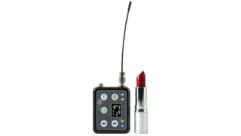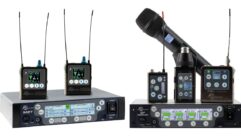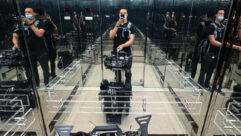Peer Review: Lectrosonics TM400
Peer Reviews: Lectrosonics TM400; Price: $1,890 MSRP
DesignPerformance
Lectrosonics TM400 digital hybrid wireless system
Price: $1,890 (MSRP)
Company website:www.lectrosonics.com
Plus: Convenient, compact, and durable transmitter and receiver package; frequency selectable RF; includes compandor-free audio path and phantom power for test microphones
Minus: Some signal degradation compared to a standard mic cable; questionable durability of external power supply connector
AT SIA Acoustics, we use measurement microphones in a number of applications: measuring loudspeakers both in our lab and on job sites, setting up sound systems, and measuring room acoustics issues such as reverberation and ambient noise conditions. There are several issues that present problems for using standard wireless systems in critical measurement applications such as increased self noise, distortion, and noise artifacts due to companding deviations of frequency and phase response and range. However, the Lectronsonics unit successfully addresses most of these issues for all but the most extremely demanding situations.
The TM400 system consists of a UH400TM transmitter and R400 receiver. The receiver chassis design is compact, functional, and durable. The complete package, along with a measurement microphone, notebook computer, miscellaneous cables, adapters, etc. easily fits in a backpack or briefcase-type kit.
The UH400TM transmitter features the same type of “plug-on” design Lectrosonics is known for. It’s small and durable, and includes a protective cordura case. It includes frequency, audio level, phantom, and power controls. Phantom power is selectable at 5, 18 or 48 V. The operating frequency is selected by turning two small pots with a miniature screwdriver.
The receiver is also small at about 5 1/2 inches wide, 6 1/4 inches deep, and 1 RU high. Two removable whip antennas are provided. The balanced XLR audio output level is variable from -50 to + 5 dBu. The receiver uses an external wall wart power supply and incorporates a locking-type chassis connector. Although the locking power connector is a good idea, this design’s durability could be an issue because the locking features aren’t obvious and lock into a fragile plastic receptacle.
The SmartTuning feature for finding clear frequencies is particularly quick and easy, especially because no external computer software is required. The Lectrosonics unit provides 256 different frequency options for its RF transmission — an increasingly important concern as HD television and other telecom applications crowd the wireless microphone system RF operating range. The SmartTuning feature uses the unit’s receiver as a spectrum analyzer so users can quickly locate a clear band for operation and easily set up the receiver and transmitter for trouble-free use.
Peer Review: Lectrosonics TM400
Peer Reviews: Lectrosonics TM400; Price: $1,890 MSRP
Value
We found the operating range to be very good, operating cleanly at more than 300 feet through concrete and steel and much, much farther with a clear line of sight. Given the size of most venues, coverage of sound systems, and limitations of typical measurement systems, range shouldn’t be a concern for most users. If more range is required, Lectrosonics recommends adding a more directional, higher gain antenna to the system. Interestingly, SIA-Smaart-users will find that even with the stock “whip” antennas, the wireless system’s range will typically exceed the amount of delay that can be applied to the measurement signal.
To explore the performance of the TM400, we made a series of measurements using an Earthworks M30 microphone connected to an SIA-Smaart-equipped computer via a standard microphone cable and then repeated the measurements using the TM400 to provide a wireless connection. We found that the TM400’s frequency response is very close to the manufacturer’s published specifications.
MANUFACTURER SPECIFICATIONS
R400 RECEIVER
Operating Frequencies (MHz): Block 22: 563.200 to 588.700, Block 27: 691.200 to 716.700
Frequency Adjustment Range: 25.5 MHz in 100 kHz steps
Receiver Type: Triple conversion; superheterodyne
Frequency Stability: ±0.001%
Front-End Bandwidth: ±30 MHz, @ -3 dB
Sensitivity: 20 dB Sinad: 1 uV (-107 dBm), A weighted; 60 dB Quieting: 1.5 uV (-104 dBm), A weighted
Squelch Quieting: >100 dB
AM Rejection: >60 dB, 2 uV to 1 V
Diversity Method: Phased antenna combining
FM Detector: Digital pulse-counting detector operating at 300 kHz
Audio Performance: Frequency Response: 20 Hz to 20 kHz (± 1 dB)
THD: 0.2% (typical)
Latency: 1.5 mS
SNR at Receiver Output: 107.0 dB
Audio Test Tone: 1 kHz, -50 to +5 dBu, <1% THD
External Power: 8 VDC min to 18 VDC max, 1.6 W; 200 mA max
Weight: 13 ounces
Dimensions (WxHxD): 5.50 x 1.75 x 4.75 inches (6.25 inches deep including knob and connectors)
UH400TM TRANSMITTER
Frequency Selection: 256 frequencies in 100 kHz steps
RF Power Output: 100 mW (nominal)
Pilot Tone: 25 to 32 kHz; 5 kHz deviation (in 400 Series operating mode)
Frequency Stability: ±0.002%
Deviation: ±75 kHz (max)
Spurious Radiation: 60 dB below carrier
Equivalent Input Noise: –118 dBV (A-weighted)
Input level: Nominal 2 mV to 300 mV, before limiting; >1V max, with limiting
Input Impedance: 1k ohm
Gain Control Range: 43 dB; semi-log rotary control
Frequency Response: 30 Hz to 20 kHz (±1 dB); LF roll-off is 12 dB/octave
THD: 0.2% (typ. 100 Hz to 20 kHz)
Latency: 1.5mS
Phantom Power Selector: 5 V @ 18 mA max, 18 V @ 15 mA max and 48 V @ 15 mA max, plus OFF
Battery Life: 4.5 hours (alkaline); 12 hours (lithium)
Weight: 6.6 ounces (including lithium 9 V battery and antenna)
However, our results revealed one minor difference between wired and wireless operation: The low-frequency response drops by 3 dB at 30 Hz, and we found a very small 1 dB rise between 8 kHz and 16 kHz, which could be attributed to the physical size of the transmitter attached to the microphone. Otherwise, it’s flat between 30 Hz and 8 kHz. We also found up to 180 degrees of phase shift at the extreme low and high ends of the audio spectrum.
One interesting note is that the Lectrosonics system utilizes a hybrid analog/digital transmission system. In this design, the audio data is digitized and the digital data is transmitted over an analog RF format. Lectrosonics claims that, “Because the information being transmitted is digitally encoded, immunity to noise (in the RF transmission) is much higher than a compandor can offer. Because the encoded audio is sent in analog format, spectral and power efficiency and operating range are not compromised.” We found this claim to be mostly true. One byproduct of the A/D conversion, which is done in 24-bit, 88.2 kHz format, is that the system shows an overall delay of about 3.25 ms. Users making critical measurements such as crossover alignments should be aware of this latency.
While the TM400 frequency and phase responses could be better at the extremes of the audio spectrum (below 30 Hz and above 8 kHz), the response is more than acceptable for all but the most critical applications. Compared to commonly available existing wireless systems, the TM400 is uniquely well suited for test and measurements, and also makes an excellent general use, wireless microphone system.
The $1,890 MSRP may seem high at first glance, especially compared to the cost of a few high-quality cables. However, when working in union halls or other facilities where stringing lots of cable can be costly, and in relation to other wireless systems that may not offer a “measurement-quality” transmission path, the TM400 system is well priced. One feature we’d like to see in the future is a digital output, such as S/PDIF or AES-EBU, which would allow users to bring the signal into our measurement system without the need for an additional A-to-D conversion.
After testing the Lectrosonics TM400, we found it to be a very convenient tool well suited for general tests and measurements in the field. We recommend using the unit at live events such as theater, amphitheater, and sports facility applications where long cable runs can be time consuming. We found that any disadvantages of this system are small when compared to the practical considerations of working with large or complex sound systems or venues.
Sam Berkow is the creator of SIA-Smaart and principal consultant and founder of SIA Acoustics, an acoustical consulting firm in New York City. He can be reached at [email protected]. Steve Sockey is a partner and senior consultant at SIA Acoustics and former chief systems engineer for the United States Air Force Band in Washington, D.C. Steve can be reached at [email protected]










